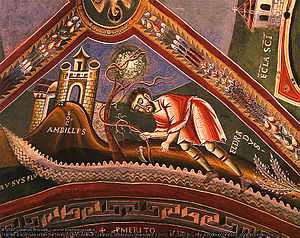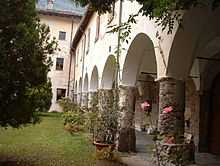Novalesa Abbey

Novalesa Abbey (Italian: Abbazia di Novalesa) is a Benedictine monastery in Piedmont, Italy. It was founded in 726, and dedicated to Saint Peter and Saint Andrew.[1]
Novalesa is in the Val di Susa, on the route to the Mont Cenis Pass, and on the former Via Francigena, a major pilgrimage road.[2] The abbey is still in operation as an active Benedictine monastery.[3]
History

The abbey was officially founded on 30 January 726, by will of local lord Abbo of Provence,[4] in a position commanding the Mont Cenis Pass pass. The founding monks are thought to have come from the Grenoble region.[5] The abbey enriched its possession through donations and privileges from the Frankish rulers Pepin the Short, Charlemagne and Louis the Pious, until its possessions reached the western Ligurian mainland. In 817 it adopted the Benedictine rule.
The first phase of the abbey's history, abbot Eldrado's era, came to an end when it was destroyed by Saracen raiders in 906.[6][7] Most monks moved to Turin, while others moved to Lomellina (in southern Lombardy) where they founded the monastery of Breme.
The abbey was rebuilt in the early 11th century by Gezo, abbot of Breme. In 1646 the Benedictines were replaced by Cistercian monks, who remained here until 1796, when they were expelled by the Piedmontese provisional government. A third refoundation occurred after the monks of a hospital established by Napoleon at the Mont Cenis (1802) moved back to Novalesa after the emperor's fall. However, they were again expelled in 1855 and the abbey's building auctioned. The complex was acquired by the province of Turin in 1972.
Description
The complex of Novalesa includes a monastic building proper, and the abbey church.

The abbey is accessed through a portal leading to a first court, with a three-span portico with cross-vaults, surmounted by a loggia. There is another court around which the building revolves: at its center are the two remaining wings of the 16th century cloister: one has five and the other has seven round arcades, supported by cylindrical columns without capitals. At the crossing between the two cloister wings is the bell tower, built in 1725-1730, which stands at 22.50 m.[8]

The abbey church is dedicated to Sts. Peter and Paul. It was built in the 18th century above the pre-existing Romanesque church from the 11th century, of which some frescoes, including the Stoning of St. Stephen, remain. The current church is in Baroque style and has a nave with barrel vaults. Half of the nave is used as presbytery, and ends in a semi-circular apse. The counterfaçade houses an organ, built in 1725.
Around the monastery are four chapels: one dedicated to Mary (8th century, restored in the 11th century), one to the Holy Saviour (mid-11th century), one to St. Michael (8th-9th centuries) and one to St. Eldradus. The latter houses a fresco cycle from the late 11th century, depicting stories of the life of St. Eldradus and St. Nicholas.
See also
Notes
- ↑ Piemontefeel - MUSEI
- ↑ Abbazia di Novalesa - abbey Turin Building Tiscover
- ↑ Montagnedoc - Culture - Abbeys - Novalesa Abbey
- ↑ piedmontese history 1
- ↑ Savorie, Provence and Alps Carolingian Visitor's Guide, Carolingian sites, French feudal coins
- ↑ The Italian Cities and the Arabs before 1095, Hilmar C. Krueger, A History of the Crusades: The First Hundred Years, Vol.I, ed. Kenneth Meyer Setton, Marshall W. Baldwin, (University of Pennsylvania Press, 1955), 51.
- ↑ In Italy Online - La Via Francigena In The "Valley Of The Abbeys"
- ↑ "Il campanile". Novalesa official website. Retrieved 4 June 2013.
| Wikimedia Commons has media related to Abbazia di Novalesa (Turin). |
External links
- Official website (Italian)
Coordinates: 45°10′47″N 7°00′30″E / 45.17968°N 7.00845°E